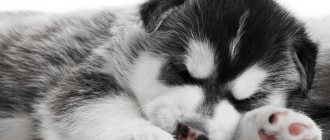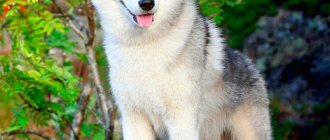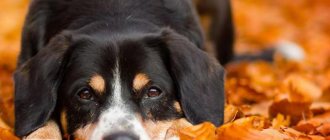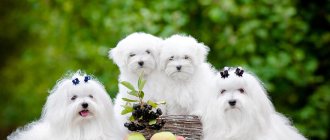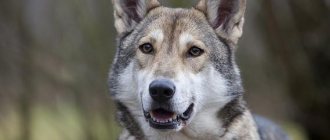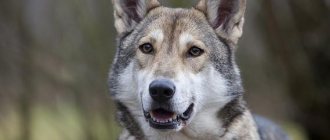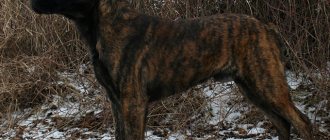The Siberian Husky is an amazing dog that looks like a snow wolf. And for good reason. This elegant wild beast is the direct ancestor of the modern husky. Most representatives of this breed have blue eyes, captivatingly beautiful and reminiscent of the native home of these creatures - Siberia. Despite their wolfish appearance, they are unusually good-natured dogs and love people with all their hearts. How to keep a Siberian Husky, a description of the breed and character, as well as what difficulties you will encounter, can be found in this article.
History of the Siberian Husky breed
This breed is considered one of the oldest. According to rough estimates, the first huskies appeared several thousand years ago. They lived side by side with the Eskimos. The task of the Siberian husky was to carry sleighs with people and cargo over long distances. This required a huge amount of strength, energy and endurance, and this is exactly what representatives of this breed are. In addition, Huskies are smart and not aggressive. People culled aggressive animals, leaving dogs with a balanced psyche and good health. Thus, the Eskimos managed to develop a truly unique breed. Huskies are not distinguished by loyalty to a single owner, like, for example, a shepherd dog. But these creatures are very kind, treat children well, are overly active and love games.
Husky: loyal friend or lone wolf?
In the modern world, choosing a dog that will fully meet all the owner’s expectations is not difficult. Be it small pets that do not require special care and long walks every day, or large breeds whose main purpose is to keep their owners safe.
According to statistics, one of the most popular breeds preferred by Russians is the Husky. Perhaps they achieved such fame because of their beautiful color and heavenly eyes, or because of their endurance and friendliness. But one thing is for sure - such dogs will be ideal companions for small children and at the same time reliable assistants to the head of the family . Huskies came from snowy Siberia and were originally bred by the Chukchi as a companion that could withstand the Siberian frost, but now dogs of this breed can easily get along in an apartment.
The standard weight of a male is 21-28 kg , females - 26-23 kg , average height 55 cm , they live about 12-15 years . Of course, each breed has its own advantages and disadvantages, based on which a person can choose a suitable pet.
Animal standard
The Siberian Husky is a breed of large sled dog. These are very hardy and active animals. The breed has not lost its pristine purity and has retained the features and character of its distant ancestors of the North.
According to the standard, the Siberian Husky has a well-built, stately body, strong legs and a fox-like tail. The dog is endowed with thick, warm fur with an undercoat that prevents it from freezing even in the most severe frosts. The color of the Siberian Husky comes in different types. Most often it is black and white, fawn, red and white, gray. White Siberian Huskies are very rare. They are considered very beautiful representatives of the breed. The white husky puppy is pictured below.
The dog has large erect ears. The Siberian Husky's eyes are slightly slanted. The most common colors are blue and brown. But there are also odd-eyed huskies, and this is not considered a defect.
The weight and height of a dog depend on its gender. Males typically weigh 26-28 kg. Their size varies from 54 to 60 cm. Females weigh between 20-23 kg. The sizes are about 50-55 cm.
Another pleasant feature of the Siberian Husky dog is that their fur does not emit an odor. Surprisingly, this breed is characterized by increased cleanliness.
Pomsky appearance
The exterior of a Pomsky is a variable value, highly dependent on the play of genes. For example, the first generation of puppies (F1) receives an equal number of external characteristics from their parents, which allows them to look half Husky and half Spitz. Usually, to produce offspring, they take a Pomeranian male and a Husky female, since a miniature Spitz “girl” will not be able to bear and produce relatively large mixed breeds. In most cases, insemination is carried out artificially, since sires that match each other in size are a rare phenomenon.
F1 Pomskies can interbreed with each other, but the end results of such “unions” will be slightly less impressive. In general, each subsequent mating (starting from F2) does not have the best effect on the appearance of the offspring. Not only will the mestizos of later generations differ in all respects from their older brothers and sisters, but this is also a direct path to degeneration. Perhaps this is why there are so few advertisements for the sale of F3 animals in Russian nurseries.
Pomsky face
The average Pomsky of the first generation is a 5-7 kg merry fellow with a height of about 30-40 cm. Sometimes the dog’s weight does not fit into the given limits, significantly exceeding them, so 10-12 kg mestizos are not such a rarity. Sexual dimorphism in Pomskies also occurs. So, almost all the “girls” are a kilogram or two lighter than the “guys” and 5-10 cm shorter than them.
Fox type Pomsky
To streamline the external characteristics of dogs and make it easier for potential buyers to choose a pet, dog experts have identified and described five main exterior types of Pomsky.
- Fox type - combines the stretched body format of a husky and the graceful bones of a spitz. The pointed shape of the muzzle, red-red color and smooth semi-long hair give the dog a resemblance to a fox.
- The plush husky is a corpulent fluffy dog with a soft, airy “fur coat” and a short Spitz muzzle. It has a thick, donut-curled tail and inherits the coat colors of a husky.
- The white Pomsky is the rarest and largest type. Characterized by a solid white color and an elegant muzzle.
- The Brown Blueeye is the most photogenic Pomsky variety and is rarely seen. All representatives of this “clan” are distinguished by the rich brown color of their coat and nose with a blue tint to the iris. In addition, they are bony, dense dogs with semi-long double hair and elongated muzzles.
- The short-haired type is a clear outsider in the star Pomsky family. The owner of a hard and ultra-short coat, which is why it is not in consumer demand.
Coat colors
The most common shade of Pomsky coat is the husky color with a characteristic mask on the face (sometimes it may be absent). It usually comes in black and white, silver grey, fawn, brown, copper and white. Tan and solid colors are also not uncommon, unlike merle varieties.
Eyes
Everything that would be considered a defect in other breeds is the norm for the Pomsky. In particular, many mestizos are characterized by heterochromia (differing eyes). Often you can see “splashes” of a contrasting shade on the iris of dogs. As for colors, Pomsky eyes most often have brown, tan, blue and walnut green shades.
Siberian Husky: description of the breed and character
This dog is distinguished by its innate friendliness towards people. They completely lack a sense of aggression, and if it somehow manifests itself in a pet, then this is a sad result of improper upbringing and a disturbed psyche.
The breed was bred as a working sled, capable of tirelessly pulling a sleigh for several hours. That is why for modern Siberian Husky dogs there is nothing better than racing in a sled through the snow. Moreover, they can do this for several hours without getting tired.
The dog is endowed with a hunting instinct, and it can easily catch small animals, but it will not bring its prey to its owner.
Husky is in no way suitable for the role of a guard, since the breed does not have aggression towards humans. Seeing a stranger on their territory, they will immediately rush to lick and caress him. If the owner tries to make a watchman out of the dog, then nothing good will come of it. As a result, the owner will only receive an animal with a crippled psyche, which even the most experienced dog handler will not be able to rehabilitate.
The Siberian Husky is a kind, inquisitive and extremely active dog that needs frequent exercise and long walks. If you do not allow your pet to release energy in the right direction, it will take it out on furniture, wallpaper and other things.
These are photogenic and elegant dogs. The huskies in the photo always turn out one hundred percent.
The Siberian Husky has above average intelligence. They are quite trainable, but it is important to take into account certain characteristics of the breed. Huskies are real stubborn people. In order for your pet to carry out this or that command, you need to be able to interest him.
Advantages and disadvantages
To summarize our article, I would like to systematize everything that has been said for clarity. So that those who are now thinking about purchasing a Husky can once again appreciate all the advantages and disadvantages of this breed.
Advantages:
- good nature;
- sociability;
- ease of care;
- cleanliness;
- no dog smell;
- high intelligence;
- most often they are quiet, but they can remember their ancestors and howl at the moon;
- for people who love to travel it will become a faithful companion;
- gets along well with children and other pets;
- touching appearance;
- is not afraid of either cold or heat.
Flaws:
- this is a very active dog. Without the physical exercise she needs, she may even get sick and fall into apathy;
- the predator is hidden at the genetic level, so mice, rats, alien cats may be in danger (as well as pigeons, sparrows, chickens and other living creatures that resemble game);
- These animals have practically no fear, which means everything is bad and with a sense of self-preservation. Try not to let him out of the yard alone, and keep him on a leash while walking. There is a very high risk of getting hit by a car;
- You need to show leadership qualities to earn the dog's respect and show that you are still the owner here. If brought up incorrectly, she becomes uncontrollable and excessively mischievous;
- during molting, you will have to do more work to clean your home from fur;
- not suitable for apartment living. Difficult to tolerate small spaces;
- cannot stand loneliness and constantly needs communication;
- not suitable for home security;
- It is a very active animal and requires constant activity from its owner.
Which of the advantages or disadvantages of this breed will be the most important for you when making a decision, you will decide for yourself, and we will add several reviews from those people who are already lucky enough to be the owner of this wonderful dog. Just remember that any pet will need your love and care.
Choosing a puppy: boy or girl?
The great moment came when all family members decided that for the next ten years a Siberian husky, a descendant of the snow wolf, would live side by side with them. The question follows: where to choose a puppy and not make a mistake with the purchase? You can often find advertisements on the Internet where they sell puppies of this breed almost for nothing and pass them off as purebreds.
Unfortunately, in most cases these are mixed breeds and not entirely purebred dogs. The price of a Siberian Husky puppy averages 20 thousand and above. If it is important for future owners to have a purebred dog that meets the standard, then they need to contact trusted breeders. They must show documents of the dogs and the parents of the puppies for authenticity.
Babies must be well-groomed, clean and moderately well-fed. Like all children, they are active, inquisitive and playful. If the puppy sits listlessly on the sidelines and does not pay attention to the movement around him, then most likely he is sick.
Often future owners are faced with the following question: who to choose - a boy or a girl? It all depends on personal preference. Males, as is commonly believed, are wayward by nature, larger in size, bold, active and stubborn. Boys require a more serious upbringing and approach. Bitches have a more developed hunter instinct, they are affectionate, calm and more human-oriented. But not everything is so simple. There is a chance to get an affectionate male with a calm character and, on the contrary, an overly active female. All animals, like people, have their own individuality.
How to choose a puppy
The main rule is that you can only buy a baby in specialized nurseries or from well-known breeders. This will give you much more guarantee that the grown animal will fully comply with breed standards and be in good health. Buying a husky puppy online or on the market is completely out of the question. Even if they really offer you a purebred baby, how can you check in what conditions the dog was kept, what the puppy, as well as its parents, were fed? No one can guarantee you correct and timely vaccination. And these are all the components of your pet’s future health.
Purchasing a Husky puppy from a breeder or kennel has other benefits. Firstly, you get the opportunity to directly communicate with all the puppies of the litter, evaluate their character, temperament and intelligence
Secondly, gain a lot of important information about the behavioral characteristics of animals, their diet, and habits. An experienced and responsible breeder will definitely answer all your questions, ask why you chose a Siberian Husky, and give practical advice on care and maintenance.
Thirdly, a puppy from a nursery or from a recognized breeder must have all the necessary accompanying documents, from a pedigree to a veterinary record with data on vaccinations and deworming.
A Siberian Husky puppy can be taken home at approximately two months of age. Try to meet your baby as often as possible, walk and play with him. Many breeders recommend taking an older animal - the dog already has some skills and is more disciplined, and the new owner will simply have a little less educational tasks at first.
It will also be useful to know that each husky raised in a kennel has its own brand. It is usually placed on the inside of the dog's ear or on the dog's belly.
Raising a pet
As a rule, a puppy is taken from the breeder at the age of 2-3 months. It is at this tender age that you need to start parenting. The puppy should have his own place where he can sleep and take a break from playing. You cannot pamper your pet by allowing him to climb on the bed, explaining that “he is still small.” A husky will not always be a baby, and when he grows up, he will literally sit on the neck of his owners.
The puppy should also eat in one place, and preferably at the same time. There should be no handouts from the table so that the dog does not grow up to be a beggar and a thief.
The puppy must buy toys so that he sharpens his teeth and does not chew furniture. If the baby still begins to spoil things, then you need to immediately divert his attention to the game.
How to choose a puppy?
Sometimes choosing a puppy confuses the buyer. It is difficult to discern the character behind the endearing appearance of a funny toddler, and therefore a person usually follows his emotions. You should only buy a puppy from a trusted breeder in a kennel. In this case, the baby must have a pedigree, as well as a veterinary passport.
And this, in turn, will affect his susceptibility to various diseases. In addition, such puppies may experience mental instability. You need to take a baby from the nursery who is active, cheerful and excellent at communicating.
As a rule, such a dog is not taken as a gift; it is a conscious choice for a person who is ready to care for and raise a child. We will have to weigh whether the future owner will be able to not only walk and feed the dog, but also raise it, care for its fur, teeth, ears, eyes, and take it to the veterinarian. You can’t go after a puppy without having any idea about him at all. Ideally, a veterinarian could help here by examining the baby.
Small puppies in the kennel behave differently.
When examining, you need to pay attention to the teeth, ears and eyes. If there are problems, it will be visible to the naked eye
In addition, the puppy’s appearance will allow you to understand the conditions in which it was kept. When meeting, you can also see socialization.
Training a Siberian Husky: how to curb your pet’s difficult temperament
Representatives of this breed are very smart and many commands literally catch on the fly. But there is one difficulty: huskies are quite stubborn and independent in nature. The owner requires a huge supply of patience and iron will. Dogs sense the owner’s mood well, and if the owner is too soft or unsure of himself, the pet will not listen to him.
Physical violence of any kind is unacceptable. In this case, the husky will simply be afraid of the person and there can be no question of any obedience. It is important to control yourself and be able to demand unquestioning obedience. The dog must understand that the person in front of him is his leader. This can only be achieved through daily practice.
The main thing in training a Siberian Husky is the ability to attract his attention to you. At first, when the puppy is still small, classes should be carried out in a fenced area, where nothing will distract him. Training should take place in the form of a fun game. The first commands that a puppy should learn are: “Come to me”, “Sit” and “Nearby”. For each completed task, the baby should receive a reward in the form of a treat. After just two weeks of training, good results will be visible. After the puppy learns the first commands, you can proceed to the following: “Give me a paw,” “Lie down,” “Die,” and so on.
If the dog stubbornly does not want to obey, then you need to seek help from a canine specialist who will correct shortcomings in upbringing and help train the ideal pet.
Caring for a Siberian Husky
Before getting a dog, you should definitely find out how to keep a pet and what it requires. Caring for a Husky is not difficult. During the molting period, in spring and autumn, the pet should be combed to prevent the fur from matting. It is not necessary to bathe Siberian Huskies often. These creatures have virtually no odor and only need to be washed when necessary. Eyes, ears and nose should always be clean.
In hot regions during the summer, Siberian Huskies may feel uncomfortable. The pet needs to be poured cold water as often as possible and given the opportunity to hide in the coolness.
In order for the Siberian Husky to feel good, and the owner along with him, the dog must be exposed to physical activity. Ideally, this is running in a harness, but failing that, ordinary active ball games will do. You need to walk your husky at least 4-5 hours a day. If you do not pay enough attention to the physical activity of your pet, then soon he will ruin things and the whole house from a boring pastime.
Dog character
The Husky's character is unusually lively . This is a sociable, playful, agile, unusually intelligent animal. A special feature of this breed is its sportive nature. Imagine that your best friend is very passionate about sports.
In order for your communication to be close, you will have to lead an active lifestyle yourself. If you prefer leisurely walks along the embankment or the main street of the city, with a dog keeping up with you on a long leash, then the Husky is not for you.
This dog is suitable for active young people for whom morning jogging is as familiar and necessary as for their pets. Even if your morning walk was really active, it won't be enough. There should be at least two such walks a day, or even three. And remember that no weather conditions can cancel the walk.
As a watchman, the domesticated breed of northern wolves does not cope well with its duties. This is too good-natured and friendly animal. She is well disposed towards guests and strangers. So, if thieves break into your house, it is possible that your security guard will greet them with all his broad soul.
In relationships with children, Huskies are ready to support any frisky and fun game. This breed has a protective attitude towards children. They take the child under their care and care for him to the best of their ability and understanding. They enjoy playing with children and devote all their time to them. Well, it’s not worth talking about the fact that every child will be glad to have such a cheerful and furry friend.
Huskies have a very difficult time being alone. Do not get this breed if you work a lot and there are no other people in your home. Alone, the dog becomes uncontrollable. It can ruin furniture, chew clothes, and later becomes disobedient and untrainable.
It is not recommended to raise your voice, even if you are unhappy with something or during training. By shouting you will only achieve that they will no longer take you seriously . It is better to speak calmly, confidently, clearly and firmly.
What difficulties might you encounter?
Huskies are hyperactive creatures and have extreme difficulty sitting still. If you leave the dog alone for a long time, pay little attention to it and do not stress it physically, then you won’t be surprised to see the apartment in complete chaos next time.
Almost all owners of Siberian Huskies have encountered difficulties in training, and this is due to their proud, independent character. It must be taken into account that this is not a service dog, and the pet will not just follow commands. The main thing for him is interest and proper motivation. You can interest your dog with a game or a favorite treat.
Another problem that owners of this breed encounter is the loss of pets. Since huskies are very freedom-loving creatures, they often break off their leashes or simply run away from their owners in an unknown direction. Unfortunately, this phenomenon is not uncommon. Just in case, you should indicate on your pet's collar the phone number and address where he lives so that the person who finds the dog can help bring him home.
Japanese Husky (Akita Inu)
Japanese Husky is the popular name for Akita Inu. They are one of the 14 oldest indigenous breeds. The Akita Inu's homeland is the Japanese island of Honshu. Traditionally used as watchdogs and hunting dogs. During the Second World War, the Akita was actively used as a service dog, so the owners began to cross it with a German shepherd in order to avoid being sent to the front (at that time, German shepherds were under state protection).
The Akita Inu is a Spitz-shaped dog that looks like a large husky. The Japanese grow up to 70 cm and weigh up to 40 kg. They are distinguished by a harmonious physique and long, dry limbs. The ears are triangular and set high. Almond-shaped eyes are set wide apart. The coat is thick and of varying lengths. The undercoat is abundant and soft. Color can be white, brindle and white-red.
These dogs are known for their calm nature and ability to be trained. A sharp mind allows them to make independent decisions. Akita Inu are prone to self-will and stubbornness. At the same time, they are brave, friendly and loyal dogs.
Nutrition of the Siberian Husky
To keep your dog healthy and strong, you need to monitor its diet. What to feed a Siberian Husky? The owner has two choices - natural and ready-made food. A natural diet should include the following products:
- meat (beef, turkey, veal);
- cottage cheese (once a week);
- eggs (once a week);
- vegetables (zucchini, beets, potatoes);
- cereals (buckwheat, rice, oatmeal).
You need to add one tablespoon of vegetable oil to meat and porridge. This improves the dog's digestion and promotes normal bowel function.
If you choose ready-made food, you need to pay attention to the “premium class” label. It already contains all the necessary vitamins and minerals for your pet.
Your dog should always have fresh, clean water available.
Diseases of the Siberian Husky
Unfortunately, even such cheerful and physically strong creatures can feel unwell. Sometimes Siberian Huskies get quite seriously ill. The cause may be an unbalanced diet, insufficient care, or lack of physical activity. A pet can also “catch” a disease by eating something on the street or by interacting with a sick dog.
A number of diseases to which Siberian Huskies are susceptible:
- oncology;
- glaucoma;
- hypertension;
- allergy;
- cataract;
- adenoma.
To prevent the disease, you need to carefully monitor your pet and take him to the veterinarian more often. Husky is a fairly hardy breed and with good care can live about 14-15 years.
Keeping a dog in a private house and apartment
Representatives of this breed are unpretentious in terms of housing and can easily live anywhere, as long as the owner is nearby. Many people mistakenly believe that Siberian Huskies cannot live in an apartment, but this is not true. The main thing is to walk with your pet more often and not let him get bored within four walls.
In the private sector, living conditions for the Siberian Husky are somewhat better than in an apartment. As a rule, in such a place there is a fenced area where the dog can run as much as he wants. If the pet will live on the street, then you should take care in advance and build a spacious enclosure for it. The house should have a wide canopy, the purpose of which is to protect it from direct rays of the sun.
The pet will rest and sleep in the enclosure, and should spend the rest of its time outside. Even if a husky lives in a private house with its own plot, it still needs long and active walks. It is also worth considering that dogs of this breed love to dig holes and can cause damage to plants and flowers. Those places where the husky can accidentally misbehave will need to be fenced off.
Mixture and comparison
Sled breeds were formed under comparable conditions, which is why there are dogs similar to huskies in color and appearance.
Huskies and huskies
They differ in their scope of use. Huskies are draft breeds bred in the North. Laikas are designed for hunting. Huskies are ready to work around the clock, huskies run out of steam much faster. Huskies are silent, reserved dogs. They express emotions by purring and howling. Laikas are big fans of making noise. Huskies have a powerful constitution, blue eyes and a bushy, fox-like tail. Laikas have an elegant structure, and their tail is curled into a donut shape.
Husky and malamute
Malamutes are designed to carry heavy loads at low speeds. Huskies are used to carry light loads over long distances. They develop high speed. The Malamute is larger and more massive than the Husky. Its average height is 60 cm. It is distinguished by its fluffy coat. The husky's pile fits well to the body.
For a malamute, blue eyes are a breed deviation, for a husky it is the preferred color. The husky has a crescent-shaped tail, while the malamute has a more furry tail. He moves like a fan. Huskies are not characterized by aggressiveness; it is easy to find a common language with them. Malamutes are strong, independent dogs that strive to dominate their owner. They quickly get bored with standard training. The owner must be able to keep the Malamute occupied, otherwise he will come up with entertainment himself.
Northerners are not only tireless workers, but also handsome. This inspires breeders to create unexpected crossbreeds. These include:
- A cross between a husky and a spitz. This mixed breed is called a Pomsky. He is a miniature Spitz-shaped dog with a characteristic husky color. Adults weigh from 3 to 14 kg, the size of the Pomsky is unpredictable. They have a friendly, playful nature and get along well with children.
- A cross between a shepherd and a husky. This beautiful mixed breed looks like a shepherd with blue eyes. Activity and friendly character are the heritage of the husky. Their appearance depends on the predominance of one or another blood. This crossbreed loves to imitate loud noises, including alarms and sirens. Also, these mestizos tend to run away from their owners, so they should not be lost sight of.
- A cross between a Husky and a Labrador. This hybrid looks like a Labrador with blue eyes. Cases of heterochromia are common. The character is dominated by the traits of a Labrador, but in a stressful situation the firmness inherent in a husky appears.
- Another common mixed breed is Akita Inu and Husky. He is a husky with the characteristic Akita coloring.
Mixed breeds are no worse than purebred dogs, but often suffer from genetic disorders. Therefore, when getting such a pet, you need to be prepared for unpleasant consequences.
Is it worth buying a Siberian Husky?
Before purchasing a puppy, you need to know why the breed was bred. Siberian Husky dogs are natural runners and thrive in sleds. These are not lap dogs that can live quietly within four walls and go out for a walk twice a day. The Siberian Husky requires a lot of attention. For people-athletes who love an active lifestyle, the dog will be an excellent friend and companion. For those who prefer to stay at home, it is better to abandon the idea of getting a Siberian Husky, since living will be uncomfortable not only for the owner, but also for the pet.
Origin story
Husky is a collective name for a group of northern sledding breeds. Their purpose is to pull a team and transport small loads. These breeds are distinguished by their strength, endurance and ability to run fast.
The Chukchi are considered the “parents” of the husky. They crossed native species with wolves. The result was excellent working dogs capable of pulling sleds over vast distances. This made it possible to hunt large animals and expand the boundaries of their possessions. It was the Chukchi huskies that became the ancestors of the Siberian ones.
The Eskimos also appreciated wolf-like dogs and began to breed their own varieties. The name Husky comes from the abbreviation Eski: this is what Canadians called Eskimos. Northerners valued the breed not only for its fantastic endurance, but also for its unpretentiousness in food: they could be fed dry fish.
Sled dogs played an important role in the lives of their owners. They were full members of the tribe and were highly respected. According to some customs, huskies were invited into the house after the birth of a child and the dogs were allowed to warm the baby.
The Husky group includes:
- Siberian;
- Alaskan;
- Sakhalin;
- Japanese;
- Klee Kai (mini husky).
They have comparable performance data, but differ in appearance, character and habitat.
Owner reviews
On the Internet, the owners of snow wolves often leave comments about their behavior, characteristics of the Siberian Husky breed and content.
Some write that this is a real hurricane in the form of a dog, which destroys everything in its path. You can only let your pet off a leash in a fenced area, as huskies have a tendency to run away. They are not guards and will not guard the house, like an Alabai or a German Shepherd.
Judging by the reviews, Siberian huskies are not easy to train; they require long walks, not simple ones, but with loads.
Dogs of this breed do not feel loyalty to one person, as they are independent. By nature, they, like cats, adore freedom and do not like to be commanded.
It is difficult to catch “one wave” with a Siberian Husky dog. But they are able to love all family members equally. Huskies are very friendly and just love playing with children. If you provide your pet with comfortable living conditions, give him the necessary exercise, and pay enough attention, then the dog will certainly respond with great and all-encompassing love.
Attitude towards children
Huskies and children in an apartment can get along quite well if the kids treat the animal with respect. However, a husky will never offend even the most capricious child. They are completely devoid of aggression, and therefore will never bite or scare their little owner. However, you should not leave your baby alone with the dog, as the husky can be too playful. During play, the pet may involuntarily push the child or knock him to the floor, which is quite likely in apartment conditions.


